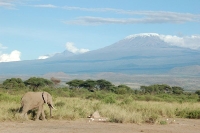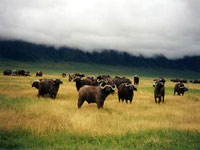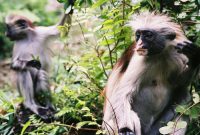
Rising 19,341ft (5,895m) above the African plains, the magnificent solitary peak of Mt Kilimanjaro is the dominant feature of this national park, surrounded by a vast protected area. The lush rainforest on its lower slopes is home to a number of animals including elephant, buffalo, rhino, monkey and leopard. The dormant volcano is remarkable in many ways, not only for its snow-covered peaks and glaciers rising out of a humid equatorial jungle, but also because it is the highest freestanding mountain in the world, a huge cone unattached to a mountain range, and Africa's highest peak. The magnetism of its twin summits and slopes has attracted researchers, mountaineers, naturalists and adventurous travellers for years. It is the only mountain of its size that can be scaled by inexperienced hikers, although altitude sickness is common and can be fatal.There are six different routes up Mt Kilimanjaro with varying degrees of difficulty, and a wide range of organised treks and experienced guides available, but the easiest and most popular way to reach the summit is on the Marangu Trail, which takes about five days, with nights spent in huts along the way. Views from the top are breath-taking, especially at dawn, and the sense of achievement experienced is incomparable. The best time to climb the mountain is between August and November.
Address : The Kilimanjaro National Park headquarters is situated at Marangu
Website : www.tanzaniaparks.go.tz

Rising above the plains of the Serengeti, the Ngorongoro Conservation Area is a vast, UNESCO-listed protected area that includes the important archaeological site of Olduvai Gorge and its main attraction, the Ngorongoro Crater. Once the site of an active volcano, the crater was formed about two million years ago when its cone collapsed on itself. Today the crater floor, supplied with permanent water and grazing and ringed with towering forested sides, serves as a natural cradle for an astounding abundance of wildlife. With an incredible width of 12 miles (20km) and a depth of 2,001ft (610m), the crater is the largest caldera in the world and is home to tens of thousands of animals, including rhino, buffalo, and large herds of zebra and wildebeest. There are also dense concentrations of predators attracted by the large variety of grazers, and prides of lion with magnificent black-maned males are one of the highlights. The lakes attract a rich variety of birdlife, including flamingos, and wallowing hippos, while some animals can be found surrounding the crater rim or on the forested slopes, such as giraffe and elephant.The views from the crater rim are spectacular and all the lodges are situated along its edge affording superb vistas over and into the crater. Access onto the crater floor is by four-wheel drive only and a game ranger must accompany all vehicles.
Website : www.ngorongorocrater.org
Meaning 'endless plains' in the Masai language, the Serengeti is Tanzania's oldest park and one of the world's best wildlife refuges, continuous with Kenya's Masai Mara Game Reserve to the north. The open plains are home to an estimated three million large mammals involved in seasonal migration, and together with the birds and smaller animals it has the largest concentration of wildlife in the world. The Serengeti is famous for the Great Migration, possibly the most astounding occurrence in the animal kingdom that is known to humankind. During this time millions of hoofed animals, predominantly wildebeest, form one massive herd and leave the dry plains of Tanzania in search of greener grazing and water to the north. Bringing up the rear of the procession are the weak, the young and the crippled, followed closely by large numbers of vigilant predators, including lions, cheetahs, hyenas and wild dogs. The season varies according to the rains, but the best time to witness the northward migration is usually from the beginning of June and again on their return in mid-November.If not coming for the migration, the best time to visit this famous national park is between January and March, when the grazers are calving and the weather is dry and sunny.
Website : www.serengeti.org

Said to be the most biodiverse national park in Tanzania, Udzungwa Mountains National Park is less a magnet for game viewing than for hiking. A network of forest trails criss-crosses the peaks and offers treks to hidden waterfalls and majestic vistas. A popular hike is the half-day trip to Sanje Waterfall, while the two-day hike along Mwanihana Trail provides panoramic views of the surrounding valleys. Other spots to hike to include cultural and historical sites like the Mwanaruvele and Magombereka Caves.While Udzungwa Mountains National Park isn't known for its game, there are still plenty of exotic animals to spot, including birds, mammals, reptiles, amphibians, butterfly and other creatures. The Iringa Red Colobus Monkey, and the Sanje-Crested Mangebay, both found only in Tanzania, can be spotted in the park.The best time to visit Udzungwa Mountains National Park is between June and October, which is the dry season (although rain is possible any time of year).

Travel Guide powered by Word Travels, copyright © 2023 Globe Media Ltd. By its very nature information in this travel guide is subject to change at short notice and travellers are urged to verify information on which they're relying with the relevant authorities. Neither Globe Media Ltd nor Travel Vogue can accept any responsibility for any loss or inconvenience to any person as a result of information contained above.